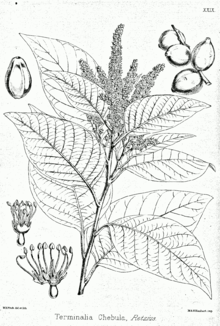Terminalia chebula
| Terminalia chebula | |
|---|---|

| |
| A leafless T. chebula tree | |
| Scientific classification | |
| Kingdom: | |
| (unranked): | |
| (unranked): | |
| (unranked): | |
| Order: | |
| Family: | |
| Genus: | |
| Species: | T. chebula
|
| Binomial name | |
| Terminalia chebula | |
| Synonyms[1] | |
| |
Terminalia chebula, commonly known as black- or chebulic myrobalan,[2] is a species of Terminalia, native to South Asia from India and Nepal east to southwest China (Yunnan), and south to Sri Lanka, Malaysia, and Vietnam.[2][3]
Taxonomy
Swedish naturalist Anders Jahan Retzius described the species.
Many varieties are known, such as:[3]
- T. c. var. chebula - leaves and shoots hairless, or only hairy when very young
- T. c. var. tomentella - leaves and shoots silvery to orange hairy
Description
T. chebula is a medium to large deciduous tree growing to 30 m (98 ft) tall, with a trunk up to 1 m (3 ft 3 in) in diameter. The leaves are alternate to subopposite in arrangement, oval, 7–8 cm (2.8–3.1 in) long and 4.5–10 cm (1.8–3.9 in) broad with a 1–3 cm (0.39–1.18 in) petiole.[3] They have an acute tip, cordate at the base, margins entire, glabrous above with a yellowish pubescence below.[citation needed] The fruit is drupe-like, 2–4.5 cm (0.79–1.77 in) long and 1.2–2.5 cm (0.47–0.98 in) broad, blackish, with five longitudinal ridges.[3] The dull white to yellow flowers are monoecious, and have a strong, unpleasant odour. They are borne in terminal spikes or short panicles. The fruits are smooth ellipsoid to ovoid drupes, yellow to orange-brown in colour, with a single angled stone.
Distribution and habitat
T. chebula Is found throughout South East Asia - India, Sri Lanka, Bhutan, Nepal, Bangladesh, Myanmar, Cambodia, Laos, Vietnam, Indonesia, Malaysia, Pakistan, Sri Lanka, Thailand. In China: Native in W Yunnan; cultivated in Fujian, Guangdong, Guangxi (Nanning), and Taiwan (Nantou).
In India it is found in the Sub Himalayan tracks from Ravi eastwards to West Bengal and Assam, ascending up to the altitude of 1 500 m in the Himalayas. This tree is wild in forests of Northern India, central provinces and Bengal, common in Madras, Mysore and in the southern part of the Bombay presidency. [4]
Habitat: Dry slopes up to 900 m (3000 ft) in elevation.[5]
Cultivation and uses

This tree yields smallish, ribbed and nut-like fruits which are picked when still green and then pickled, boiled with a little added sugar in their own syrup or used in preserves. The seed of the fruit, which has an elliptical shape, is an abrasive seed enveloped by a fleshy and firm pulp. It is regarded as a universal panacea in Ayurveda and in the traditional Tibetan medicine. The fruit also provides material for tanning leather and dyeing wool,silk and cotton.
Seven types of fruit are recognized (i.e. vijaya, rohini, putana, amrita, abhaya, jivanti, and chetaki), based on the region where the fruit is harvested, as well as the colour and shape of the fruit. Generally speaking, the vijaya variety is preferred, which is traditionally grown in the Vindhya Range of west-central India, and has a roundish as opposed to a more angular shape.[5]
Chemical composition
A number of glycosides have been isolated from haritaki, including the triterpenes arjunglucoside I, arjungenin, and the chebulosides I and II. Other constituents include a coumarin conjugated with gallic acids called chebulin, as well as other phenolic compounds including ellagic acid, 2,4-chebulyl-β-D-glucopyranose, chebulinic acid, gallic acid, ethyl gallate, punicalagin, terflavin A, terchebin, luteolin, and tannic acid.[5][6] Chebulic acid is a phenolic acid compound isolated from the ripe fruits.[7][8] Luteic acid can be isolated from the bark.[9]
T. chebula also contains terflavin B, a type of tannin, while chebulinic acid is found in the fruits.[10]
Gallery
-
Trunk of T. chebula
-
Fruit of T. chebula
-
A fallen fruit
References
- ^ "The Plant List: A Working List of All Plant Species". Retrieved 7 August 2015.
- ^ a b "Terminalia chebula Retz". Germplasm Resources Information Network. Agricultural Research Service, United States Department of Agriculture. Retrieved 6 Aug 2016.
- ^ a b c d Flora of China: Terminalia chebula
- ^ http://haritaki.org/range-of-haritaki-terminalia-chebula/
- ^ a b c http://www.toddcaldecott.com/index.php/herbs/learning-herbs/361-haritaki
- ^ Saleem, A.; Husheem, M.; Härkönen, P.; Pihlaja, K. (2002). "Inhibition of cancer cell growth by crude extract and the phenolics of Terminalia chebula retz. Fruit". Journal of Ethnopharmacology. 81 (3): 327–336. doi:10.1016/S0378-8741(02)00099-5. PMID 12127233.
- ^ Lee, H. S.; Jung, S. H.; Yun, B. S.; Lee, K. W. (2006). "Isolation of chebulic acid from Terminalia chebula Retz. And its antioxidant effect in isolated rat hepatocytes". Archives of Toxicology. 81 (3): 211–218. doi:10.1007/s00204-006-0139-4. PMID 16932919.
- ^ Lee, H. S.; Koo, Y. C.; Suh, H. J.; Kim, K. Y.; Lee, K. W. (2010). "Preventive effects of chebulic acid isolated from Terminalia chebula on advanced glycation endproduct-induced endothelial cell dysfunction". Journal of Ethnopharmacology. 131 (3): 567–574. doi:10.1016/j.jep.2010.07.039. PMID 20659546.
- ^ Nierenstein, M.; Potter, J. (1945). "The distribution of myrobalanitannin". The Biochemical Journal. 39 (5): 390–392. doi:10.1042/bj0390390. PMC 1258254. PMID 16747927.
- ^ Han, Quanbin; Song, Jingzheng; Qiao, Chunfeng; Wong, Lina; Xu, Hongxi (2006). "Preparative isolation of hydrolysable tannins chebulagic acid and chebulinic acid from Terminalia chebula by high-speed counter-current chromatography" (PDF). J. Sep. Sci. 29: 1653–1657. doi:10.1002/jssc.200600089.
citation Lee H 2006 was published in 2007. (PubMed)
External links
- Caldecott, Todd (2006). Ayurveda: The Divine Science of Life. Elsevier/Mosby. ISBN 0-7234-3410-7. Contains a detailed monograph on Terminalia chebula(Haritaki; Abhaya) as well as a discussion of health benefits and usage in clinical practice. Available online at http://www.toddcaldecott.com/index.php/herbs/learning-herbs/361-haritaki
- Detailed content on Terminalia chebula, (Haritaki) medical research, uses, benefits, history, and global distribution. http://www.haritaki.org



